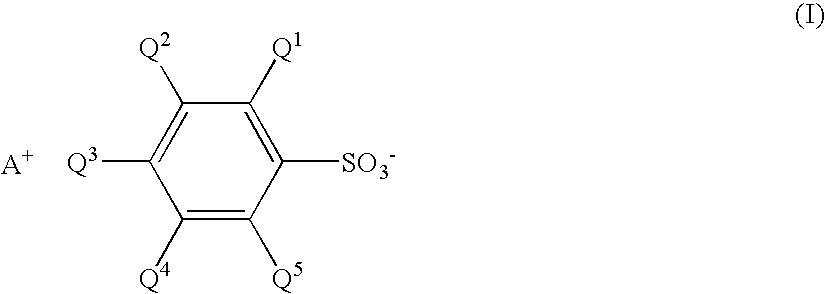Sulfonate and a resist composition
a technology of resist composition and sulfonate, which is applied in the direction of photosensitive materials, auxillary/base layers of photosensitive materials, instruments, etc., can solve the problems of low throughput in the production of integrated circuits for low sensitivity of resist composition, uneven line width, and difficult to combine roughness and pattern shape progress, etc., to achieve excellent various resist abilities such as sensitivity, resolution, and improved line edge roughness and pattern profiles
- Summary
- Abstract
- Description
- Claims
- Application Information
AI Technical Summary
Benefits of technology
Problems solved by technology
Method used
Image
Examples
synthesis example 1
RESIN SYNTHESIS EXAMPLE 1
Synthesis of Resin A1
(1) 39.7 g (0.16 mol) of 2-ethyl-2-adamantyl methacrylate, 103.8 g (0.64 mol) of p-acetoxystyrene and 265 g of isopropanol were charged into a flask and the mixture was heated to 75° C. in a nitrogen atmosphere. To the heated mixture, the solution consisting of 11.05 g (0.048 mol) of dimethyl 2,2-azobis(2-methylpropionate) and 22.11 g of isopropanol was added dropwise. The added mixture was stirred at 75° C. for 0.3 hour and was maintained to heat under reflux for 12 hours. The resultant mixture was diluted by acetone. The diluted mixture was poured into large amount of methanol, and then filtered to obtain copolymer of 2-ethyl-2-adamantyl methacrylate and p-acetoxystyrene in the form of wet cake containing methanol. The weight of the wet cake was 250 g.
(2) Into the flask, 250 g of the wet cake obtained in (1), 10.3 g (0.084 mol) of 4-dimethylaminopyridine and 202 g of methanol were charged, and the mixture was stirred under reflux f...
synthesis example 2
RESIN SYNTHESIS EXAMPLE 2
Synthesis of Resin A2
(1) The reaction and post treatments were conducted in the same manner as in Resin synthesis example 1 (1) except that the amounts of 2-ethyl-2-adamantyl methacrylate and p-acetoxystyrene were changed to 59.6 g (0.24 mol) and 90.8 g (0.56 mol), respectively, to obtain 250 g of copolymer of 2-ethyl-2-adamantyl methacrylate and p-acetoxystyrene in the form of wet cake containing methanol.
(2) The reaction and post treatments were conducted in the same manner as in Resin synthesis example 1 (2) except that the amounts of 4-dimethylaminopyridine, methanol and glacial acetic acid were changed to 10.8 g (0.088 mol), 239 g and 8.0 g (0.133 mol), respectively, to obtain 102.8 g of crystals of copolymer of 2-ethyl-2-adamantyl methacrylate and p-hydroxystyrene. The copolymer has a weight average molecular weight of about 8200 and the degree of dispersion was 1.68. The ratio of the structural unit of 2-ethyl-2-adamantyl methacrylate to that of p...
PUM
| Property | Measurement | Unit |
|---|---|---|
| Percent by mole | aaaaa | aaaaa |
| Solubility (mass) | aaaaa | aaaaa |
Abstract
Description
Claims
Application Information
 Login to View More
Login to View More - R&D
- Intellectual Property
- Life Sciences
- Materials
- Tech Scout
- Unparalleled Data Quality
- Higher Quality Content
- 60% Fewer Hallucinations
Browse by: Latest US Patents, China's latest patents, Technical Efficacy Thesaurus, Application Domain, Technology Topic, Popular Technical Reports.
© 2025 PatSnap. All rights reserved.Legal|Privacy policy|Modern Slavery Act Transparency Statement|Sitemap|About US| Contact US: help@patsnap.com



